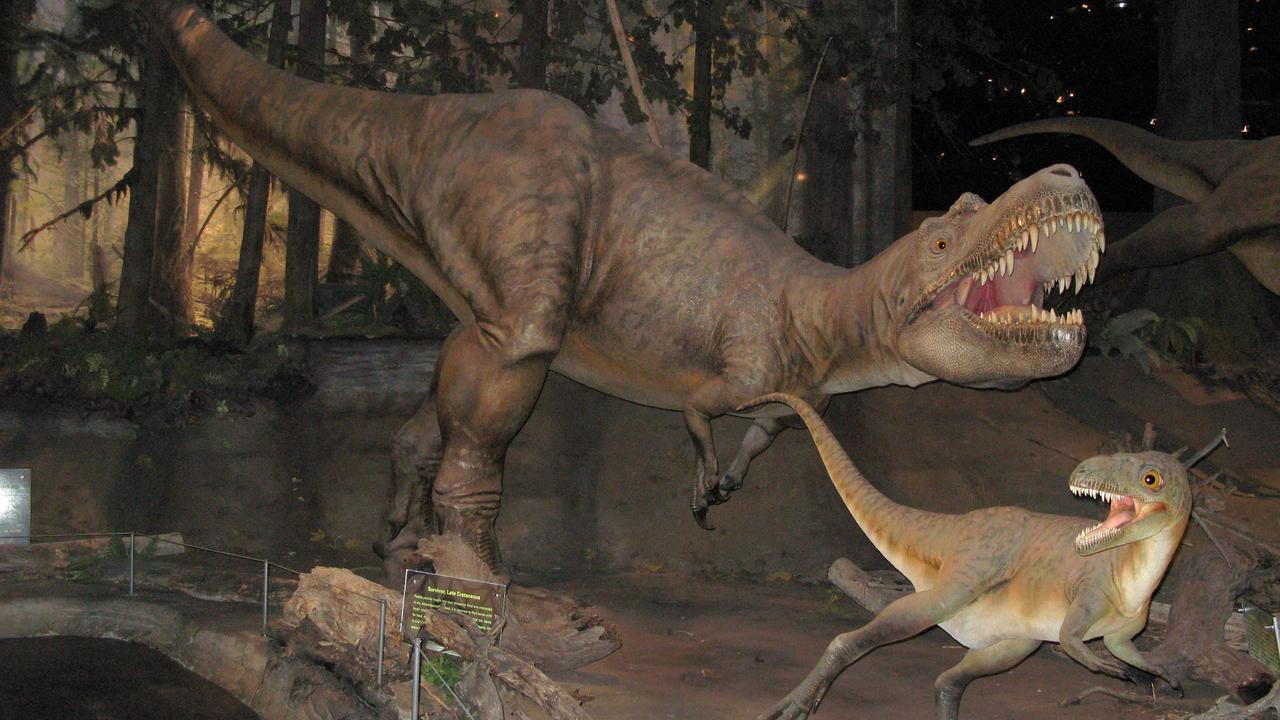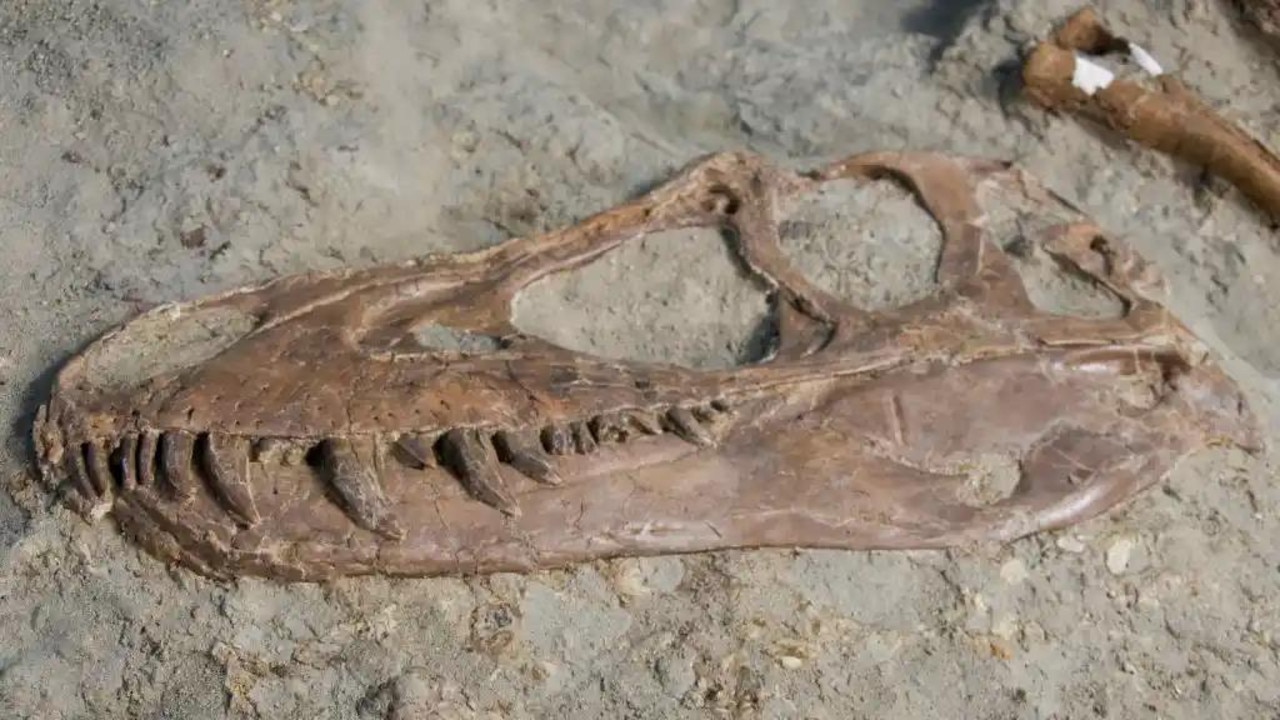‘Appetite for drumsticks’: First prey found in a tyrannosaur stomach
Newly discovered fossils show just how hungry big dinosaurs could really get

READING LEVEL: GREEN
Prey* has been discovered inside the stomach of a tyrannosaur* skeleton* for the first time, according to scientists, revealing that the mighty dinosaurs had an “appetite for drumsticks*” when they were young.
The skeleton of the Gorgosaurus*, a member of the tyrannosaurid* family that also includes the T-Rex, sheds light on how these dinosaurs grew from fairly slender juveniles* into gigantic, bone-crushing, apex-predator* adults, they added.
The Gorgosaurus – which means “dreadful lizard” – was around six years old when it died more than 75 million years ago, according to a new study in the journal Science Advances.

The fossil was discovered in 2009 at the Dinosaur Provincial Park, east of the Canadian city of Calgary. But when they got the skeleton back to the lab, the scientists noticed something strange.
The study’s lead author, Francois Therrien of the Royal Tyrrell Museum, told AFP they were amazed to “discover the remains of the last meal of this young tyrannosaur still preserved in place”.
What was most surprising, he added, was that the small leg bones sticking out of the tyrannosaur’s ribcage belonged to two young, birdlike dinosaurs called Citipes*.
Citipes are thought to have had feathers, wings and a beak and walk on two feet, somewhat resembling modern-day cassowaries*, Therrien said.
They are far smaller than the massive plant-eating dinosaurs that adult tyrannosaurs had been known to eat.

Study co-author Darla Zelenitsky, a palaeontologist* at the University of Calgary, told AFP that this particular “fussy eater” used its sharp teeth to carve itself only the legs of the two baby Citipes.
“This teenage Gorgosaurus seems to have had an appetite for drumsticks,” she said.
The discovery also offers a rare clue into how tyrannosaurs grew from one metre long at birth to some of the biggest predators to have ever walked the Earth.
“This fossil is the first solid evidence that tyrannosaurids drastically changed their diet as they grew from teenagers to adults,” Zelenitsky said.
Young tyrannosaurs had slender heads and legs, sharp knifelike teeth for dissecting carcasses*, and could probably run quite fast to catch their turkey-like prey.
These youths probably looked more similar to the velociraptors depicted in the movie “Jurassic Park” than the giant T-Rex, Zelenitsky said.

But at roughly 11 years old, as the tyrannosaurs hit their middle-age, their bodies grew almost ten times in size, ending up weighing more than 3000 kgs.
Their heads broadened and their teeth thickened into what Therrien called “killer bananas” capable of crunching through huge bones.
This transformation was driven by a change in diet, as the dinosaurs ditched the drumsticks of their youth and started preying on giant plant-eating dinosaurs.
These kind of drastic dietary changes are not necessarily rare in the animal kingdom – crocodiles and Komodo dragons start out eating insects before switching to rodents and eventually large mammals, Therrien said.

The researchers said the Gorgosaurus fossil supports the theory that young tyrannosaurs – including the T-Rex – filled a role in the food chain known as “mesopredators*”, before later growing into apex predators.
GLOSSARY
- prey: animals that are hunted and eaten by other animals
- Gorgosaurus: a specific type of tyrannosaurid dinosaur
- tyrannosaur: a type of large dinosaur with sharp teeth and powerful jaws, known for being a fierce predator
- skeleton: the frame of bones that supports the body of a living organism, in this case, the remains of a dead dinosaur
- drumsticks: the lower joint of the leg of a cooked chicken, turkey, or other fowl
- tyrannosaurid: a family of dinosaurs that includes the T-Rex and other similar species
- juveniles: young animals that are not fully grown
- apex-predator: the top predator in a particular ecosystem, usually at the highest point of the food chain
- palaeontologist: a scientist who studies fossils to learn about life in ancient times
- cassowaries: large flightless birds with colourful feathers and a distinctive bony casque on their heads
- Citipes: a type of birdlike dinosaur, thought to have feathers, wings, and a beak, resembling modern-day cassowaries
- carcasses: the dead bodies of animals
- mesopredators: predators in the middle of the food chain, not at the top like apex predators
EXTRA READING
Ancient ‘sea slayer’ identified from Jurassic seas
‘Crazy beast’ prehistoric mammal found
Monster prehistoric Aussie plant discovered
QUICK QUIZ
- What was discovered inside the stomach of the Gorgosaurus?
- How old was the Gorgosaurus when it died?
- What were the small leg bones found in the tyrannosaur’s ribcage?
- How did the Gorgosaurus change its diet as it grew older?
- How did the appearance of young tyrannosaurs differ from the adult ones?
LISTEN TO THIS STORY
CLASSROOM ACTIVITIES
1. Teenage diet
At around 11 years of age the tyrannosaurid dinosaur drastically changed its diet to eat a lot more and bigger amounts. This change could be compared to a human teenager who needs a lot more food for energy in their growing years.
Compare a teenage tyrannosaurid diet to a teenage human diet in the two columns below:
Teenage tyrannosaurid Human teenager
Time: allow 20 minutes to complete this activity
Curriculum Links: English, Science, Critical and Creative Thinking
2. Extension
How do you think this six year old Gorgosaurus died all these years ago?
Time: allow 10 minutes to complete this activity
Curriculum Links: English, Science, Critical and Creative Thinking
VCOP ACTIVITY
Adjectives
An adjective is a describing word. They are often found describing a noun. Start by looking at the words before the nouns.
Search for all the adjectives you can find in the article.
Did you find any repeat adjectives or are they all different?
Extension
Pick three of your favourite adjectives from the text and put them in your own sentences to show other ways to use them.
Have you used any in your writing?

